In this article, we are going to discuss why the AMD EPYC “Rome” generation will likely see 160x PCIe Gen4 lanes plus likely additional lane(s) for a necessary function. While all of our previous material focused on 128x PCIe lanes, in single and dual socket configurations for AMD EPYC, we are expecting a big change in 2019 with the new generations and one that Intel fully failed to address with its release this week. Intel instead focused on bringing out a large portfolio instead of addressing the fact that it is about to have a competitor with twice as many cores per socket and well over 3x the PCIe bandwidth in mainstream dual-socket systems.
I was going through our original AMD EPYC and Intel Xeon Scalable Architecture Ultimate Deep Dive piece from 2017, and our team went through some of the technical documentation on AMD EPYC CPUs, and we found something. Over the past few weeks, we have managed to confirm with a number of AMD’s ecosystem partners that our theory is not only valid, but it is indeed what we will see. What we know to be true about AMD EPYC’s dual socket configuration is going to drastically change with Rome. In this article, we are going to show you why.
On the first page, we are going to give you the background on the state of the server chip market today between Intel Xeon Scalable second generation lineups and the AMD EPYC first generation. On the second page, we are going to show you what will change to make AMD EPYC Rome and absolute monster for PCIe I/O.
Taking Stock of the 2019 Second Generation Intel Xeon Scalable CPUs PCIe
This week, we had the release of the “Cascade Lake” series of Intel Xeon Scalable processors. The second generation Intel Xeon Scalable processor family largely stuck to its roots with similar core counts as well as PCIe Gen3. The company had two mainstream products:
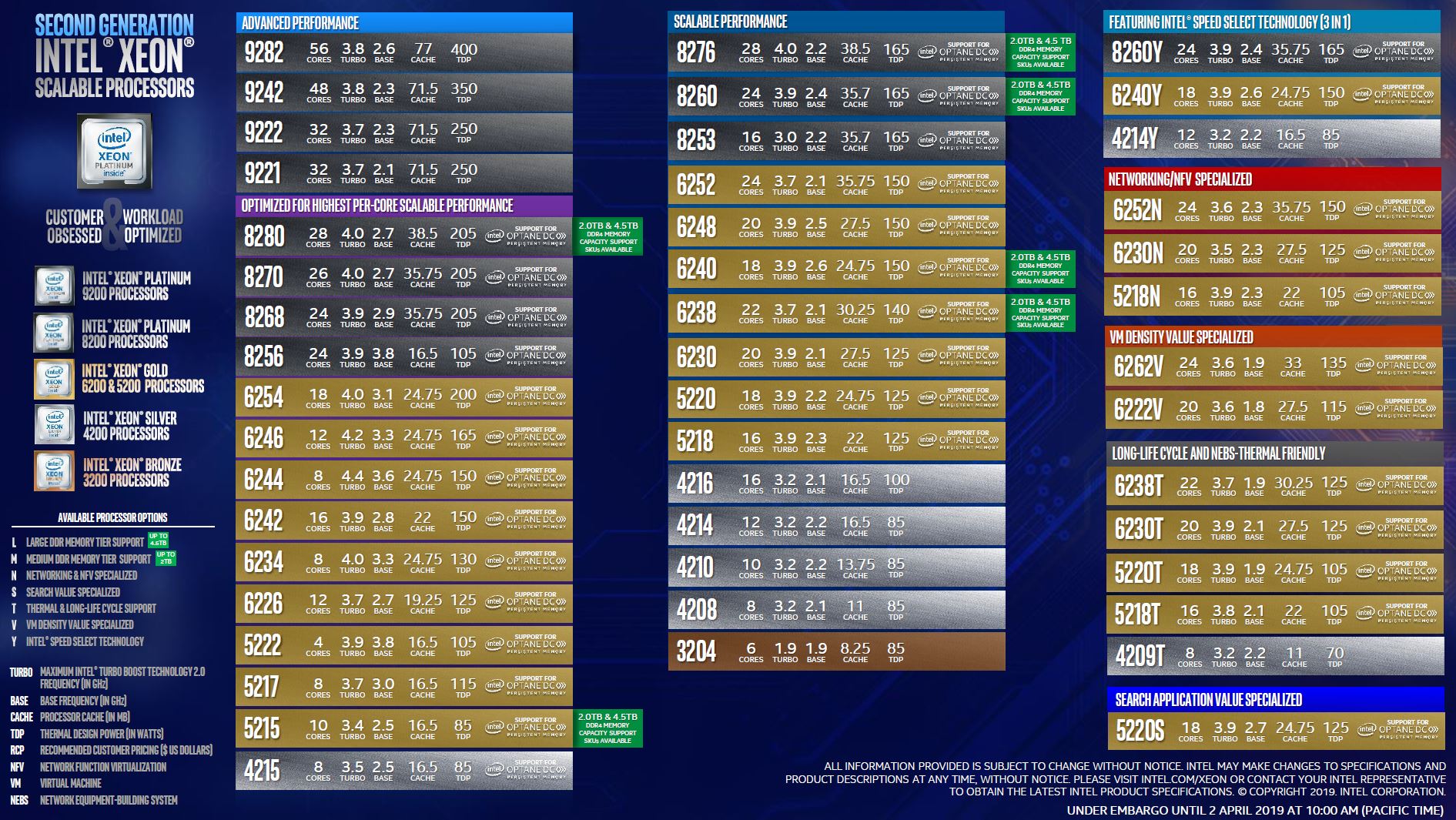
Second generation Intel Xeon Scalable CPUs (codenamed Cascade Lake) with model numbers in the Bronze 32xx, Silver 42xx, Gold 52xx, Gold 62xx, and Platinum 82xx series. Beyond this, there was the advanced performance or “AP” version of these chips that are now known as the Platinum 9200 series and formerly “Cascade Lake-AP.”
You can check out STH’s full 2nd Gen Intel Xeon Scalable Launch Details and Analysis including some benchmarks as well as our Second Generation Intel Xeon Scalable SKU List and Value Analysis to see how Intel changed its SKU stack to better align with competitive pressures from AMD EPYC 7001 “Naples” CPUs.
Intel still has a low power PCIe 3.0 x16 interface on the new second-generation chips, but it is limited to 48x PCIe lanes going directly from chip to device. The official Platinum 9200 series sleds top out at 80 PCIe Gen3 lanes in a dual socket system or less than we find on quad socket Xeon Scalable servers such as the Supermicro SYS-2049U-TR4 we just reviewed.
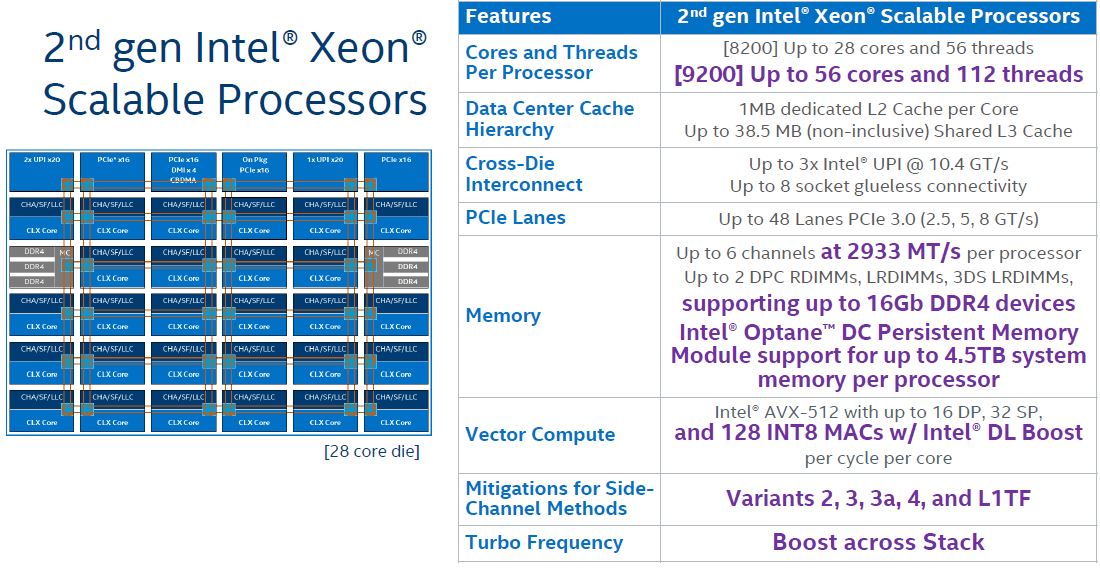
At this point, it is completely appropriate to cry foul. All of these Intel Xeon Scalable Platforms have a Lewisburg PCH. We confirmed that Intel’s Platinum 9200 series platforms also had them. The Lewisburg PCH has additional PCIe lanes connected via a DMI x4 link back to the CPU. Higher-end Lewisburg PCH options with QuickAssist accelerators and additional networking need additional CPU PCIe lanes to be routed to the PCH. Still, the SATA, networking, and PCIe lanes of Lewisburg serve an important function, keeping lower-requirement I/O off of the valuable CPU PCIe lanes. Typically, AMD EPYC has struggled here, but it seems AMD may be fixing this on some Rome systems. We are going to get to that later in this article.
Realistically, if you want high-performance PCIe 3.0 from Intel Xeon Scalable dual socket you have:
- Xeon Platinum 9200: 2 CPUs with 40x PCIe Gen3 lanes each for 80 lanes total
- Xeon Scalable Mainstream: 2 CPUs with 48x PCIe Gen3 lanes each for 96 lanes total
- Xeon Scalable 4P: 4x CPUs with 48x PCIe Gen3 lanes each for 192 lanes total
- Xeon Scalable 8P: 8x CPUs with 48x PCIe Gen3 lanes each for 384 lanes total
The Intel Xeon Scalable 8-socket servers are very popular in China because the number 8 has special significance, as does having the largest server. That topology loses a direct connection between each of the CPUs, but it can potentially provide more PCIe bandwidth than we will see with AMD EPYC Rome generations.
With the new 2nd Generation Intel Xeon Scalable CPUs covered, let us get to the current AMD EPYC 7001 “Naples” CPUs, and then to what is changing in Rome.
AMD EPYC 7001 Series “Naples” Background
To understand what changes with AMD EPYC “Rome” later this year, we need to start with the current “Naples” generation. The current generation managed to get a product shipped, but it did something more. It set market expectations as well as the socket for a platform that will refresh to much higher capacity parts in 2019.
With the AMD EPYC 7001 series, there are a total of eight x16 links per CPU. In a single socket AMD EPYC 7001 server, this gives us 128x PCIe Gen3 lanes.
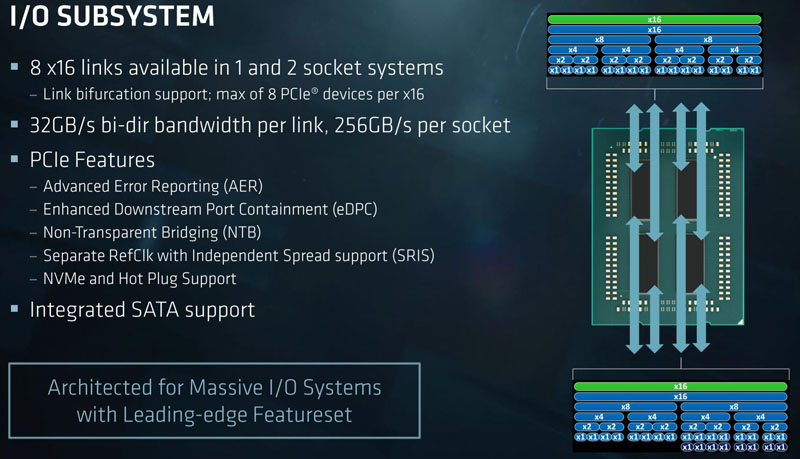
In a dual socket server, each die has a direct link to its sister die on the other socket. This uses one of the two x16 links running in Infinity Fabric mode. When I discuss the AMD EPYC 7001 series Infinity Fabric link between sockets, I usually tell people to conceptually think of it as a PCIe Gen3 x16 link between dies plus a little bit of extra juice. That is not entirely accurate, but most acquiesce that it is a decent rough conceptualization.
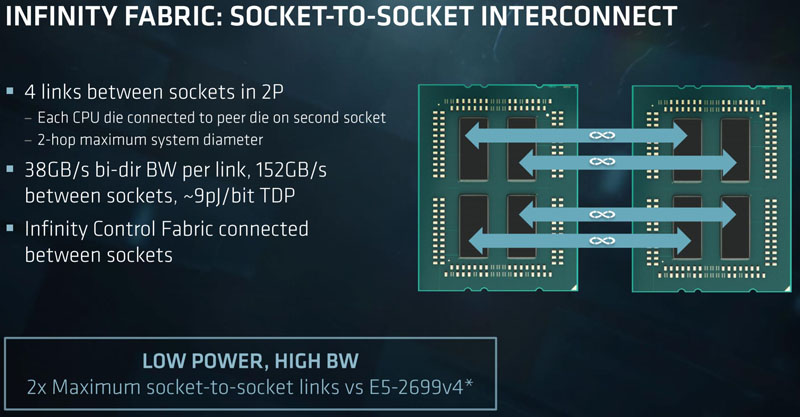
Together, the AMD EPYC 7001 “Naples” Infinity Fabric looks like this:
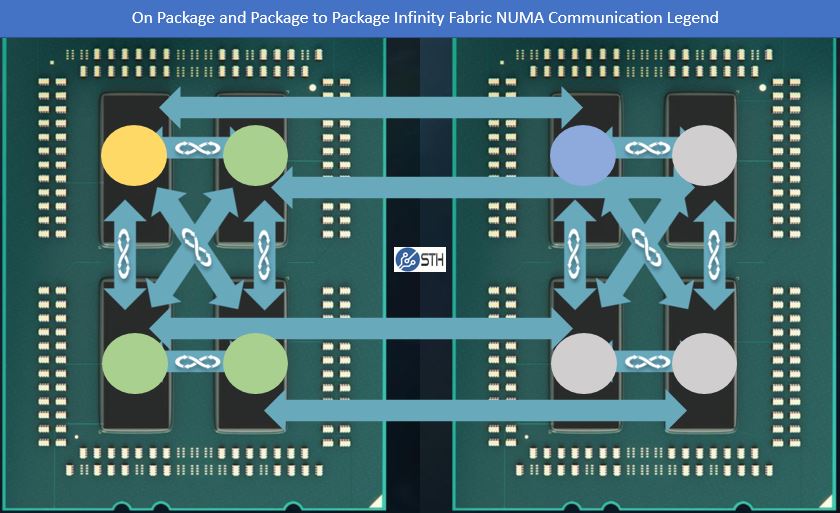
The die marked with yellow has on-package Infinity Fabric links to each die marked with green. It traverses the slower and longer x16 Infinity Fabric link to the die marked in blue on the other socket. It has two-hop link options to each die marked in grey.
Next we are going to show what we expect to change in the next generation, including what may be an awesome but underrated architectural improvement.

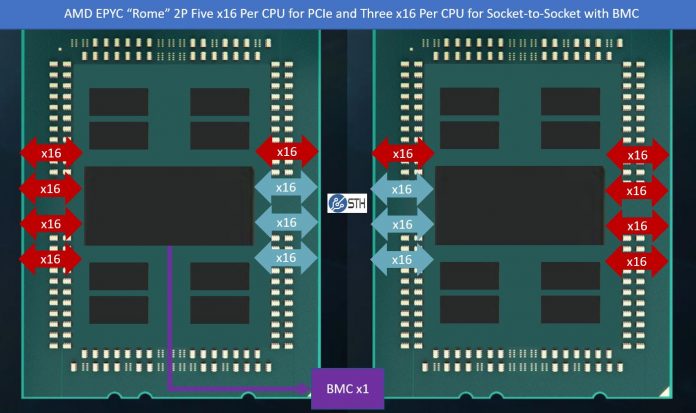



So there’s fewer links dedicated to package-to-package communication that frees up some for PCIe.
That’s great, but AMD made a huge deal about the “socket compatibility” of these new Epycs… aside from the fact that PCIe 4.0 ain’t going to work on an old motherboard without the repeater chips, an old motherboard also won’t rewire itself do deliver all these lanes.
On top of that, how practical is it to be using all of these lanes in a real-world 1U or 2U server anyway?
This is really smart by AMD’s engineers.
Don C – they’ve addressed those points in the article p. 2
I wouldn’t believe it otherwise, but this guy is the #1 server bro in the world right now.
That sounds like a real winner so long as the rome cores don’t suck and the io die to core isn’t crippling
Regarding socket compatibility, are there extra pins on Epyc’s socket that were unused with Naples but would now be defined as PCIe contacts for Rome to enable this bonus PCIe lane?
We buy servers fully integrated in racks, so this is far down the stack from what I’m usually dealing with.
You’ve done a good job dumbing down the explanation so someone who doesn’t come from hardware engineering can understand what they’re doing.
Jonathan they’ve even got GPIO from the SCH that they can use.
As my kids say “yeet” AMD. Cascade’s been out hours and already looks like a dinosaur.
Only one thing left to wonder about, how fast is the connection between the chiplets and the I/O die? I think it’s a very clever design to get around the limitations posed by NUMA with first generation EPYC, it is somewhat ironic that Intel is moving in the opposite direction putting two separate dice into the high end Cascade Lake CPUs.
I can’t help but question the utility of this cpu package interconnect. Amd can create as much bandwidth as they like between cpu packages but all that bandwidth is totally wasted with CPUs that clock at around 2.2 – 2.6GHz while Intel is already selling 3.8-4.0+ Xeons that run on such speed for dozens of cores. Either workload is CPU bound or it is not. When it is then CPU tacts matter and the interconnect bandwidth is not that important anymore. All AMD is doing is removing the past bottleneck but they still hugely under perform Xeons. I see zero applicability for HPC workloads.
The only HPC benefit I can see is that you could now do 8 GPUs and 2 nics in a system at twice the bandwidth to the CPUs as Intel, and you don’t need pcie switches which the HPC codes don’t like.
If AMD’s got faster memory 3200 rumored and gen4 that’s a lot of good before knowing what the CPU pipeline
Honestly I never tire of touching myself because I’m such a fanboy.
@Matthias Wolf: You realize that AMD can also sell lower core-count parts clocked higher if that’s what you want, right? AMD has had no problems hitting 3.5GHz on Zen so there’s no reason to expect they’d backpedal on that now.
Re. HPC, IDK, I thought a big chunk of HPC cared about DRAM bandwidth; a bigger chunk than those that care about peak flops. 8-channels > 6-channels no? Yes, there’s cascade lake AP to post high scores on benchmarks, but that’s a completely new board. And HPC still connects I/O like Infiniband, Storage, no?
“but they still hugely under perform Xeons” In what? Linpack? Sure. Generally? Not “hugely” and this is speaking of Sky/Cascade vs Zen. Recall nobody without an NDA has seen Zen 2 yet.
@Don Cornelius: AMD’s stated objective with Zen/Naples was to replace low/mid core-count 2P intel systems with a 1P naples. Hence the I/O. Apparently many folks bought 2P because 1P XCC was too expensive and didn’t have enough memory/I/O (so say AMD marketing, so pinch of salt and all that, but it sounds plausible). View it in the light of that fact. If the only reason you were 2P was to get gobs of I/O, you now have a solution in 1P. If you really needed lots of memory channels and memory in addition to lots of cores, 1P is probably not for you. You could extend the argument to 4P->2P consolidation although that’s a bit weaker.
Also, compatibility generally means backward compatibility in this business. My understanding is that Rome plugged into an older board will default to PCIe-3 which satisfies that definition. It is not as if newer features cannot be introduced (AVX123, TSX, etc).
@Matthias Wolf: While Intel is already hitting these high boost clock rates, they do so at the expense of a massive amount of power. Remember that Intel bases their TDP off of base clock, so with all cores running at 2.5GHz the 8180M uses 205W, once it boosts their TDP can easily double so that 205W becomes 410W. Now with the new 56C it has a 400W TDP which means while boosting each socket could pull 800W! Your 2 socket server with any cards/drives in it will need a 2000W PSU minimum. AMD does have their 16C high core clock Epyc and it looks excellent. I would assume they will do the same thing with the Epyc 2 line but perhaps have higher core variants.
@Jeremy: The 8180 can sustain up to 3.2GHz on all 28 cores in some non-AVX workloads. But these are nowhere near 3.8-4.0GHz on dozens of cores that Matthias Wolf claims. Intel ups the 8280 all core turbo boost to 3.3GHz and the 4GHz turbo is only achieved on 2 cores.
“the release of the “Cascade Lake” series of Intel Xeon Scalable processors”
Amazing, Intel can keep selling products and even market new products that all have the “Spoiler” security hole with NO effective patch, and people keep enjoying paying more for “Spoiler Inside”!
Researchers discover and abuse new undocumented feature in Intel chipsets
Researchers find new Intel VISA (Visualization of Internal Signals Architecture) debugging technology.
ZDnet March 29, 2019
Hard times for intel and it’s followers.
AMD document 54945 “PPR for AMD Family 17h Model 01h B1” lists WAFL PCS w/ x2 E12G PHY in chapter 1.7 Processor Overview. Did Naples already have these “WAFL Bonus PCIe Lane(s)”?
@deltaFx2, AMD never did with previous server CPUs. Can? Perhaps but perhaps not. Tact frequencies on most all previous server CPUs by AMD underperformed Intel on an equal core count comparison basis. Memory speed and bandwidth is almost always of lesser priority than cpu tact frequencies in hpc space. And Intels avx512 blows amd away in that category as well. HPC hugely depends on high tact frequencies, I also know a lot of houses that work in deep learning space and run gpu compute servers and require among gpu cards fast CPUs because some of the workload is cpu bound. As I said Rome may lend itself well to certain areas but it’s not gonna be hpc or gpu compute
@Jeremy,@Alex, all right not dozens but 18 cores (6154) and 12 cores (6146), at a top 3.7ghz and 4.2 ghrz respectively. Multiply cores by 2 as those are being deployed on dual socket boards and you get your dozens. Amd only countered in November last year and even that epic chip performed poorly (7371) vs my other 6146 and 6154 Intel chips in most math computations. There is a reason that as of today hardly any hpc or gpu compute vendor utilizes epyc chips despite their high pcie lane count.
@Matthias Wolf
dare to explain this then? https://www.hlrs.de/whats-new/news/detail-view/2018-11-13/
As an HPC User I am quite intrigued by the new AMD CPUs for the following reasions:
1) Two full AVX-2 lanes
2) No downclocking, as on Intel CPUs, when AVX is fully activated.
This article has good info, but could have been written in 2 paragraphs.
Making an article unnecessarily long is wasting readers’ time. Less is more.
@Matthias Wolf:
“Memory speed and bandwidth is almost always of lesser priority than cpu tact frequencies in hpc space” Really?Take a look at this: https://arxiv.org/abs/1810.09330 “Double-precision FPUs in High-Performance Computing: an Embarrassment of Riches?” They conclude that 60-70% of HPC loads they run (RIKEN) are memory bound. I’ve also read someone from Berkeley complain about modern CPUs being optimized for cloud/enterprise vs. HPC on the memory side but I can’t find a citation now. It may well be that what you do fits well in the caches (DGEMM etc) but it’s a huge generalization from one datapoint. Also, HPC != Deep learning. There’s some overlap but in my view, HPC is Double Precision stuff. Moreover, you’re complaining about an unreleased product stack.
Unless you can get >50% utilization of FP 512 units, you are not going to be much better than AVX-256 (full width) for a given application. There are loads that can do this (*GEMM, Linpack, etc) but it’s hardly the norm. This is also why AMD is able to keep up with Xeon in SpecFP; spec FP is mostly memory bound. FP 512 is great to post linpack scores on Top500. And there certainly will be loads that vectorize well and fit in the caches. To me, AVX-512 seems an attempt to keep nVidia out of the datacenter.
As to who in HPC has signed up for rome, take a look at this: https://www.hpcwire.com/2018/10/30/cray-unveils-shasta-lands-nersc-9-contract/ And they’re not the only one.
L. P., I never claimed that nobody finds utility in this chip for HPC. I made a generalized statement. Your link provides no details how those nodes that will run on Rome CPUs is utilized. I can assure you that that not a single machine that makes use of cpu bound traffic in high frequency trading, a show case of hpc, where latencies and high throughout really matter, utilizes Epyc chips. I know of not a single one and consider myself relatively informed in this space. Are there use cases for epyc chips? For sure. But as I said, it depends specifically which workloads. Even a super computer cluster has various workloads and for some of it fpga cards make the most sense, for others high performant CPUs and for again others you want Chips with lots of pcie lanes. The article you quoted does not go into any detail on the precise use case where the Rome chips are supposed to be utilized.
@deltaFx2, I am not judging from just one data point. I am pretty well connected in the high frequency trading space where there are either fpga or cpu bound workloads involved and where nobody cares about AMD (so far) because they have no product that remotely competes with Intel or fits minimum requirements. There are now a few epyc based gpu servers out there but the large majority runs on E5 v4 machines or Xeon scalable chips. Does that constitute the entire hpc space? Certainly not, but it represents typical use cases in hpc space.
Furthermore, I have the Xeon Gold 6154 and Gold 6146 and both outperform the Epyc 7371 in various applications that involve cpu compute without any specialized optimizations on the software side for the Intel CPUs. I can’t speak for Rome as they are not out yet but I am prepared to be disappointed. Again, I am working in a nich area and can’t speak for the utility of those chips in network, web, or storage related applications. I welcome competition and hope amd eventually gets its act together. But I find the amd hype by fan boys completely over the top. Many even claim how Amd is gonna heavily eat into Nvidia’s market share in gpu space. Those are dreams and wishes but none of that is validated by trends or statistics. Equally in gpu space, AMD does not have competing products that come close in performance to what Nvidia offers in the top segment. Not even remotely close.
@Matthias
EPYC Rome has 4x the AVX performance compared to EPYC Naples, EPYC Rome has twice the L3-cache compared to EPYC Naples. Xeon Gold 6154 cost $3500, Xeon Gold cost 6146 cost $3300 where EPYC 7371 only cost $1700.
@Micha, it’s interesting that you are one of the first who mentions price because surely this category is a clear AMD win. No disagreement here. Am quite curious about the Rome AVX performance because many of my cpu bound apps peruse avx. The only way to find out is to try out. Marketing gibberish got me into the early threadripper gen1 then gen2 then epyc gen1 and all disappointed big time. I only speak for the applications that I used to benchmark performance,among many others, C++ compiled code (I used ICC but also other non Intel ones).
Would it be possible for AMD to tap those extra PCIe lanes into more sockets? 4p or 8p?
@Matthias: “Does that constitute the entire hpc space? Certainly not, but it represents typical use cases in hpc space.” Now here’s where we fundamentally disagree. You’re probably the first person I’ve come across who classifies high frequency trading as HPC. It’s an interesting argument, but HPC to me means large clusters often running MPI, solving large-scale science problems (CFD, particle physics, molecular biology, that sort of thing). And I do think trading workloads does not represent HPC workloads; trading workloads are strongly incentivised to shave off the last microsecond, something HPC does not have as strong an incentive for. My original point stands: you said “I see zero applicability for HPC workloads.” You meant “I see zero applicability for high frequency trading”. You may well be right, but you are extrapolating from one highly biased sample (I’ll grant it’s not one datapoint but several similar ones). It may also be that your application is highly tuned over the years for intel’s cache hierarchy (and it’s totally reasonable to go with intel at that point).
I don’t know or care about market shares in gpu/cpu. I just found your original claim of zero applicability very strong.
@deltaFx2, https://www.hpcwire.com/solution_content/hpe/financial-services/big-data-hpc-speeding-innovation-high-frequency-trading/
Hft is definitely part of HPC, regardless of how you or I feel about it. So are GPU compute servers. When you just look at above two areas they make up orders of magnitudes more machines than the hpc use case you described. So I guess you took issue with my points because you were slightly confused about the definition of HPC and what it encompasses. Having said that, perhaps look at hft machines or check out Supermicro and their gpu compute server products, how many Epyc based boards do you see? Same with most other vendors. I start to get the impression you just like to disagree. Epyc 7371 benchmarks vs Intel CPUs are in public domain, check them out (specifically vector compute) . I myself benchmarked the CPUs with all the applications that I need to run efficiently. Then you have hardware vendors in hpc space that stayed mostly away from Epyc chips. I am talking about facts here not your or my feelings. Let’s agree to disagree at this point and if I hurt your feelings with “zero applicability” then I apologize and happily correct it to “currently low applicability”
@Matthias You do realize that your purported conclusion is actually contradicted by your cited reference?
The logic behind the article is big data and hpc influencing high frequency trading. Not the other way around. The article furthermore treats all three areas as separate entities hence leading your conclusion ad absurdum.
@L.P., AMD itself promotes the Epyc 7371 as Chip useful for high frequency trading applications :-) AMD itself said it. And AMD sales was quoted in interviews with Anand tech. Anyone working in this space acknowledges that gpu compute and hft are both part of hpc. I pointed to the sources, feel free to look it up. And if you still disagree then, we’ll, let’s agree to disagree. I own several Xeon gold and the epyc 7371 and have run performance benchmarks. Have you? I also work in hft space and spend many hours each day on deep learning networks. I acknowledged the areas I have zero expertise in, but claim to know a thing or two about what I have been doing over the past 11 years. If Rome will solve your problem then by all means go for it. I am absolutely convinced it will not be widely accepted in hpc space.
I think you are missing the point… are you sure the topologies are going to be like that??
I have yet to read an article to explain some fundamental e crucial things about Rome and the all 3000 lineup (since all Will have chiplets + central hub, AM4 sockets is already comfirmed, debuts with 1 chiplet but has space and provisions for 2 chiplets for the high-end SKUs -> meaning all DDR channel are also attached to the I/O hub) .
. The chiplets are tiny compare with the central I/OHub which is absolutly huge (it ocupies more área than the 8 chiplets, attending the individual packaging penaltis in area, no matter if the big is 14nm or half density)
. The 8 DDR RAM channels are all directly attached to the central hub e none to any of the chiplets, i. e., the tradicional cpu-memory paradigma is decoupled… for the first time in modern times,..
https://wccftech.com/amd-epyc-rome-zen-2-7nm-server-cpu-162-pcie-gen-4-lanes-report/ for purposes of ilustration i picked the first link, but the graffic is AMD.
. In such a topology you don’t need a x16 lane link to connect to other chip/chiplets that also had direct attachement to DDR RAM, as in the previous solutions and topologies of AMD… now the all memory traffic comes from a central location… and the same lane provision in HT or Infinity Fabric, of previous iterations, is sufficient for each Chiplet (previous chips or dies in a socket) to connect to all other 15 chiplets in 2 sockets, if each x16 links can be divided in x4 (they all now only snoop caches in the background and respective very low traffic)… 3 x16 links outside Socket, is 1 x16 for the other central I/O hub, and 8 x4 for the other chiplets-> meaning all chiplets comunicantes with each other even with 2 sockets.
The 1th time i saw it… ‘wtf, huge mistake’… AMD many times is ahead of time, but others also do huge poo… 8 chiplets with 64 cores, all ‘fighting’ for memory resouces at a central hub, simply the “contention” must BE huge (more so in 2 sockets, because requests for memory can came also from the other socket) … unless there are many ways to mitigate this, which invariably passes for having the chiplets caches very well “warm up”, among some other things… Neither of this can PCIe provide or does it matter how many links, or if is gen 4 or 4K…
From what i researched PCIe absolutly can’t cope with it, but Gen-Z can…
https://genzconsortium.org/educational-materials/
Gen-Z have an “abstract physical layer”, treats at first everything as Just a Bunch of Lanes, and the “magic” is in the “Gen-Z Core” wich then knows what to do with those Lanes that attach it. Each Gen-Z core, were a Bunch of Lanes attach (no matter topology, sinal rates or modulation, i.e., NZR or PAM4), can BE parte of a “component media”, wich can be a single “device” or a collection of devices with many functions (compute, special acceleration, memory, etc), and it already support with its ‘memory semantic and plural messaging’ much more than 2000 functions, including all of the PCI/PCIe up to Gen5, that are a little more than 200 (CXL will be quite easy to have, the same with HyperTransport kind of “Cache Coerency”, which is the base for Infinity Fabric (also), and more, cause it as provisions, althought it doesn’t enforce any cache coerency, neither memory coerency for that matter, cause this depende on the implementers having the MMU/ZMMU with Address Translation, and Page Walking upon lists or matrixes, on the side of their “component device(s)”, and Cache Coherency mechanisms, on each side of a link, and goes further than the tradicional MOESI or actual MOWESI of AMD, everything is there, but depends on how or how much do you want, cause system are not going to be so simple anymore)… and all functions of PCI/PCIe cause ech G-Core takes over as a “Root Complex”, with each Device implemented in a “logic” way of extension (better than bridges), called LPD (Logic PCI Device), meaning they are already virtualized (even if it is mostly hardware), including the safe way of PCIe (Each G Core can have up to 2000 LPDs, huge collection of VMs or Containers on a server)… and a “collection” of DDR channels, connected to a Gen-Z Core, can be a “component media” also and have 100ths of adicional functions -> in the way of a data centric FULLY COMPOSABLE sistems… and connect to 1 or more switches that serve many other “components”…
Bottom line: you can have a sistem with only PCIe defined slots, attachements, etc, including U3 (with a HBA or not) and U2 for storage… but the underlayind traffic that goes behind the sceanes, is almost all Gen-Z… even having a REGULAR/NORMAL x16 adapter, Gen III or IV doesn’t matter, enjoying already up to 32 Gbps/lane, and all the 100ths of additional functions, including Memory Coerency and Cache Coherency, and as many as the adapter can support and the system offers (that is, a regular PCI-E adapter, can already be accelerated, by sitting on a PCIe slot on a system that has Gen-Z behind the all routing and interconnet, restrion being if it enforces PCI ordering PCO) (Imagine a GPU adapter, that is regular PCIe, but is also able to work with Gen-Z and all its possibilities -> https://community.amd.com/community/radeon-instinct-accelerators/blog/2018/11/13/introducing-the-world-s-first-7nm-gpu-and-fastest-double-precision-pcie-card -> 4 GPGPU cards tied togheter by Infinity Fabric, having cache and memory (their internal) coherency as one… then sitting as nothing more than regular PCIe slots, is a wast that does compute… I don’t think AMD as gone this far, all around Gen-Z no matter if all attachments are “legacy” … yet… but in here i hope there is the real bonus ).
For alleviatting Memory Media contention, there is buffer/cache with “pattern recognition”, wich can be stride for pre-fetch, regular expressions etc… and there is a possibility of called “Collective Processores”, at each switch on the Fabric, and that treats the Requests/Responses of the Collective component medias attached to that switch as a single entity (for sure alleviates contention and imposes more order on a link) …